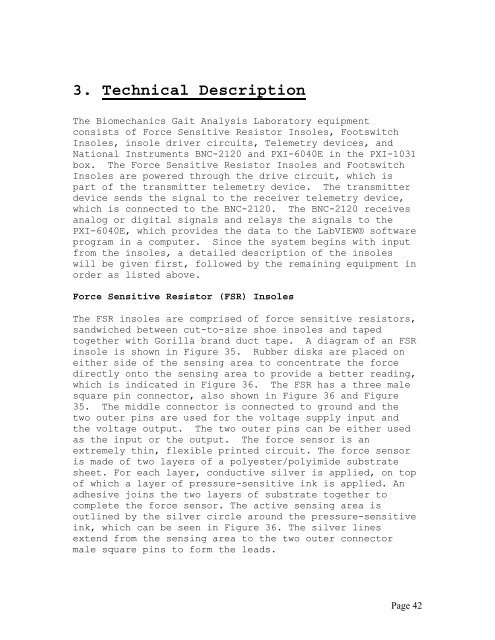Biomechanics Gait Analysis Lab - Biomedical Engineering ...
Biomechanics Gait Analysis Lab - Biomedical Engineering ...
Biomechanics Gait Analysis Lab - Biomedical Engineering ...
You also want an ePaper? Increase the reach of your titles
YUMPU automatically turns print PDFs into web optimized ePapers that Google loves.
3. Technical Description<br />
The <strong>Biomechanics</strong> <strong>Gait</strong> <strong>Analysis</strong> <strong>Lab</strong>oratory equipment<br />
consists of Force Sensitive Resistor Insoles, Footswitch<br />
Insoles, insole driver circuits, Telemetry devices, and<br />
National Instruments BNC-2120 and PXI-6040E in the PXI-1031<br />
box. The Force Sensitive Resistor Insoles and Footswitch<br />
Insoles are powered through the drive circuit, which is<br />
part of the transmitter telemetry device. The transmitter<br />
device sends the signal to the receiver telemetry device,<br />
which is connected to the BNC-2120. The BNC-2120 receives<br />
analog or digital signals and relays the signals to the<br />
PXI-6040E, which provides the data to the <strong>Lab</strong>VIEW® software<br />
program in a computer. Since the system begins with input<br />
from the insoles, a detailed description of the insoles<br />
will be given first, followed by the remaining equipment in<br />
order as listed above.<br />
Force Sensitive Resistor (FSR) Insoles<br />
The FSR insoles are comprised of force sensitive resistors,<br />
sandwiched between cut-to-size shoe insoles and taped<br />
together with Gorilla brand duct tape. A diagram of an FSR<br />
insole is shown in Figure 35. Rubber disks are placed on<br />
either side of the sensing area to concentrate the force<br />
directly onto the sensing area to provide a better reading,<br />
which is indicated in Figure 36. The FSR has a three male<br />
square pin connector, also shown in Figure 36 and Figure<br />
35. The middle connector is connected to ground and the<br />
two outer pins are used for the voltage supply input and<br />
the voltage output. The two outer pins can be either used<br />
as the input or the output. The force sensor is an<br />
extremely thin, flexible printed circuit. The force sensor<br />
is made of two layers of a polyester/polyimide substrate<br />
sheet. For each layer, conductive silver is applied, on top<br />
of which a layer of pressure-sensitive ink is applied. An<br />
adhesive joins the two layers of substrate together to<br />
complete the force sensor. The active sensing area is<br />
outlined by the silver circle around the pressure-sensitive<br />
ink, which can be seen in Figure 36. The silver lines<br />
extend from the sensing area to the two outer connector<br />
male square pins to form the leads.<br />
Page 42
















